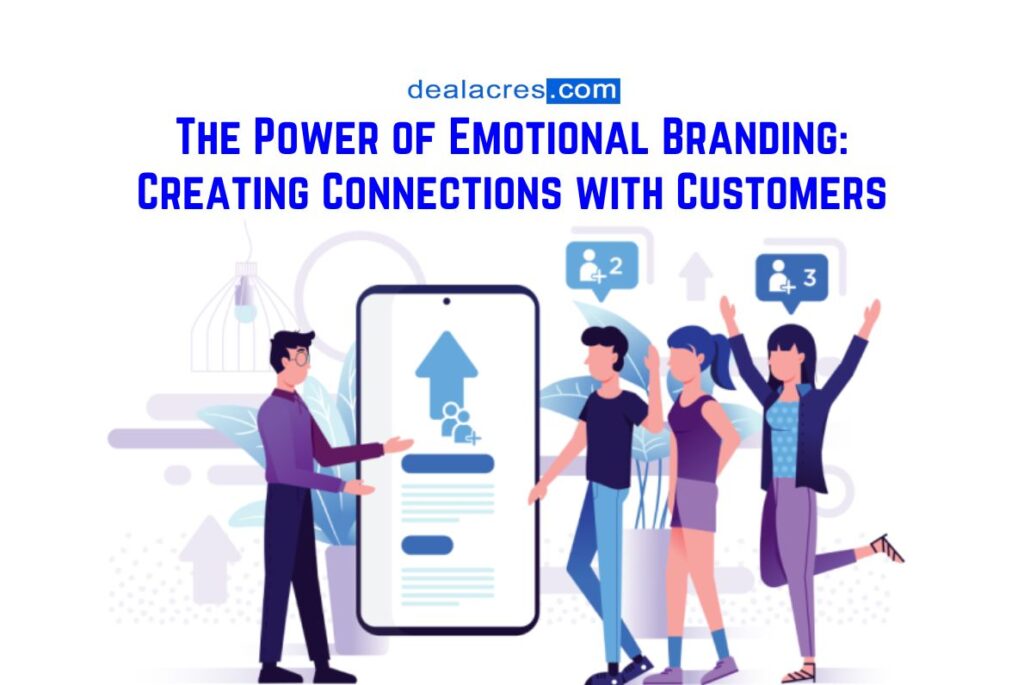In today’s world, where competition is fierce and choices are abundant, businesses are constantly seeking ways to stand out. One of the most potent strategies in their arsenal is emotional branding. This powerful technique involves connecting with customers on a deeper, emotional level rather than just selling a product or service. In this article, we’ll explore the significance of emotional branding, its impact on customer relationships, and how businesses can harness its power to create lasting connections.

What is Emotional Branding?
Emotional branding is all about forging meaningful connections with customers by appealing to their emotions, values, and aspirations. Unlike traditional branding, which focuses solely on product features or benefits, emotional branding delves into the realm of human emotions. It aims to evoke feelings such as joy, nostalgia, trust, or even a sense of belonging.
The Importance of Emotional Branding
The marketplace is crowded with similar products and services, making it challenging for businesses to differentiate themselves. This is where emotional branding comes into play. By tapping into the emotional psyche of consumers, brands can carve out a distinct identity and foster customer loyalty.
Emotional branding goes beyond mere transactions; it creates experiences that resonate with customers on a personal level. When people feel a strong emotional connection to a brand, they are more likely to become repeat buyers and enthusiastic advocates. Moreover, emotional branding can insulate businesses from price wars and fluctuations in the market, as customers are willing to pay a premium for brands they feel a deep connection with.

Building Emotional Connections
Creating emotional connections with customers requires a strategic approach. Here are some key steps that businesses can take to harness the power of emotional branding:
- Know Your Audience: Understanding the desires, fears, and aspirations of your target audience is essential for effective emotional branding. Conduct market research, gather insights, and create buyer personas to tailor your messaging accordingly.
- Craft Compelling Stories: Storytelling is a potent tool for emotional branding. Share narratives that resonate with your audience’s values and experiences. Whether it’s the journey of your brand, testimonials from satisfied customers, or anecdotes that tug at the heartstrings, storytelling humanizes your brand and fosters emotional connections.
- Authenticity Matters: Inauthenticity can quickly erode trust and undermine emotional branding efforts. Be genuine in your interactions with customers, uphold your brand values, and deliver on your promises consistently. Authenticity builds credibility and strengthens emotional bonds with your audience.
- Create Memorable Experiences: Every touchpoint with your brand is an opportunity to evoke emotions and leave a lasting impression. Whether it’s through exceptional customer service, engaging social media content, or immersive brand experiences, strive to create memorable moments that resonate with your audience.
- Foster Community Engagement: Building a community around your brand can foster a sense of belonging and emotional attachment among customers. Encourage user-generated content, facilitate interactions among customers, and leverage social media platforms to cultivate a vibrant community centered around your brand.
Examples of Emotional Branding Done Right
Several brands have mastered the art of emotional branding and have reaped the rewards in terms of customer loyalty and brand advocacy. Let’s take a look at some notable examples:
- Nike: Through its iconic “Just Do It” campaign, Nike inspires customers to push their limits and pursue their dreams. By associating its brand with themes of determination, resilience, and empowerment, Nike has cultivated a passionate community of athletes and fitness enthusiasts who identify with its values.
- Apple: Apple is renowned for its ability to evoke emotions through its products and marketing. From its sleek design aesthetics to its compelling advertising campaigns, Apple taps into consumers’ desires for innovation, creativity, and simplicity. By fostering a sense of belonging to the “Apple ecosystem,” the brand has cultivated a fiercely loyal customer base.
- Dove: Dove’s “Real Beauty” campaign challenges traditional beauty standards and celebrates diversity and inclusivity. By championing authenticity and self-acceptance, Dove has struck a chord with consumers, particularly women, who feel empowered and represented by the brand’s message.

Emotional Branding
Emotional branding is not just a marketing tactic; it’s a philosophy that places human emotions at the heart of brand-building efforts. By understanding the power of emotions in shaping consumer behavior, businesses can elevate their branding strategies to new heights and cultivate lasting connections with their audience. As competition intensifies and consumer expectations evolve, emotional branding will continue to be a driving force behind successful marketing campaigns and business growth. So, embrace the power of emotional branding, and watch as your brand becomes not just a product or service but a meaningful part of your customers’ lives.
Conclusion
Emotional branding is a powerful tool for businesses seeking to create meaningful connections with customers in today’s competitive landscape. By appealing to consumers’ emotions, values, and aspirations, brands can differentiate themselves, foster loyalty, and drive long-term success. Through authentic storytelling, memorable experiences, and community engagement, businesses can forge deep emotional bonds that transcend mere transactions. In essence, emotional branding is not just about selling products or services; it’s about creating experiences that resonate with customers on a profound level.




